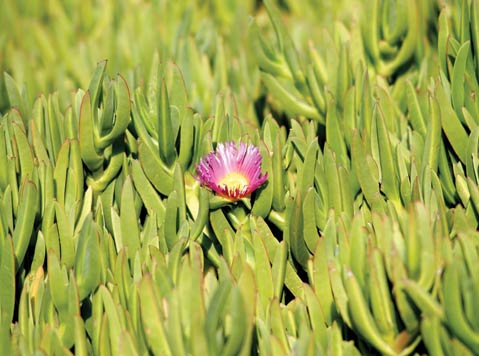Ice Plants
The Adaptable, Unstoppable Ground Cover

While the most-planted ice plant is slowly disappearing from our landscapes, there are still miles of freeway lined with this succulent groundcover, acres of coastal bluffs encrusted with it, and, yes, even local beach parks still edged with this extremely adaptable and nearly unstoppable plant. It is commonly known as ice plant, but botanists are still volleying names about, and exactly where it originated has been the subject of many a research paper. It is Carpobrotus; maybe chilensis (but maybe hailing from South Africa), or maybe a hybrid. DNA studies are still in the works trying to tease out its history. Known relatives are native to South Africa, India, and South America. It turns out it can become somewhat invasive, choking out native plant communities, and the myth that it stabilizes slopes against runoff only applies when rainfall is average or light. Heavy downpours can make it weighty enough to contribute to landslides instead of preventing them. These are two good reasons that landscapers are looking to other choices for sensitive spots.
There are other species of groundcovers that go by the name ice plant, and they all belong to the same plant family, the aizoaceae. Unfortunately, some of them also have the bad habit of being too successful in their adopted habitats. Mesembryanthemum crystallinum may be the namesake of the group. Its leaves exude droplets of liquid (a response to excessive salts in the soil) that sparkle in the sun, kind of like frost: quite a head-turner if you are visiting the arid deserts of Baja California or our Channel Islands. It is native to South Africa, where presumably something likes to eat it or is capable of out-competing it. On this coast, it can spread far and wide to the detriment of other, more fragile species.
Red apple, such an appealing name, but kind of a devil of a plant, Aptenia cordifolia can also creep its way out of bounds. Plant a nice border with it and forget to monitor its progress. Soon it has slipped down that slope and even found the prickly pile of oak leaves under that native, no real deterrent. (And gardening under oaks? Many more columns to cover that difficult subject!)
Not all ice plants are so invasive, and there are some handsome ones that can fill particular niches in many a landscape. Cephalophyllum ‘Red Spike’ grows much more slowly and blooms with showier flowers. It even takes some afternoon shade, a useful trait in some situations. Delosperma has several species and selections that play up the color variation available in this family. A particularly bright set of pigments in their flowers may be displayed in an electric array. There are two species of another colorful ice plant genus, Drosanthemum. These also display the little glistening droplets on their leaves, making them handsome even when not in bloom.
The genus Lampranthus also has several species of note. These may be the showiest of all when in flower. Carpets of this groundcover can probably be seen from space, they are so bright. With a longer bloom season but fewer flowers per square foot is Malephora. All ice plant flowers are composed of many narrow petals surrounding a nectar disk. Bees find this particularly attractive, and planting ice plants will assure a food source for them. Many ice plants are still a good pick to cover a lot of ground attractively.



